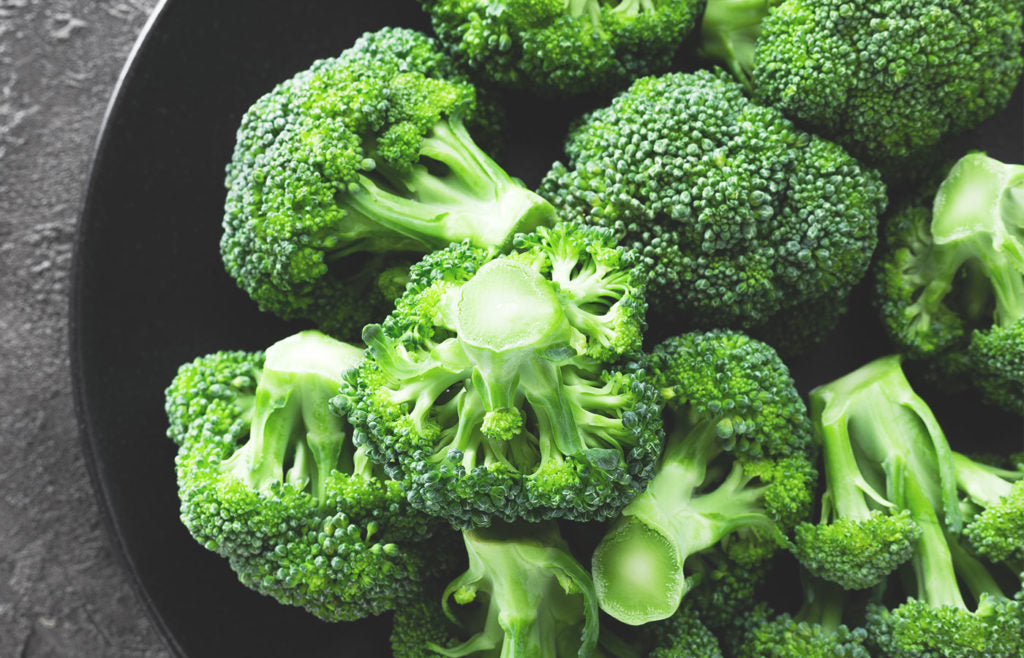
3 powerful benefits of broccoli & how to eat more of it
It turns out when our parents told us to ‘eat our broccoli’ they were doing us a huge favour for our long-term health and wellbeing!
This humble, mini-tree-like vegetable is a powerhouse of phytonutrients. A member of the cruciferous vegetable family, broccoli contains a broad range of vitamins and minerals, and is also rapidly making a name for itself as the richest source of the powerful sulphur-containing compounds known as glucosinolates.
What are glucosinolates?
Glucosinolates are found in a range of foods, including Brussel sprouts, cabbage, cauliflower, mustard, horseradish and of course, broccoli and broccoli sprouts. Glucosinolates are behind the pungent sulphurous smell of this family of vegetables, collectively known as Brassica vegetables.
When we eat broccoli, the glucosinolates are broken down into other beneficial active compounds such as indoles, thiocyanates and isothiocyanates. Isothiocyanates are produced by plants as a protective mechanism to defend themselves against the attack of pathogens (such as harmful fungi or bacteria). So, is it any surprise that we see some of these benefits passed on to us when we consume foods containing these compounds?
Sulforaphane (one of the most researched isothiocyantes from broccoli) has been shown to have a beneficial, antibiotic-like activity against a range of pathogens including E. coli, Salmonella typhimurium, Candida sp., and H. pylori. [1]
Research continues to look at the many phytonutrient compounds in broccoli for their health-enhancing benefits. A study comparing the effects of a Brassica vegetable consumption with micronutrient and fibre supplementation investigated whether the health benefits of Brassica vegetable consumption were due to the glucosinolates and the nutrient profile from consumption of the vegetable itself, or if the health benefits were simply a bonus of the vitamins and minerals consumed with the added vegetable intake. The findings of the study suggested that actual Brassica consumption reduces systemic oxidative stress, independent of the vitamin and mineral content of these vegetables. [2]
Broccoli for hormonal health
Cruciferous vegetables are making quite a name for themselves in research when it comes to positively influencing hormone metabolism. When the liver processes hormones to prepare them for elimination, it makes substances known as ‘metabolites’. In the case of estrogen there are several kinds of metabolites that the body can make, and some have protective health effects and others have been correlated as drivers of inflammation and disease, such as estrogen receptor-positive cancers.
Indoles, namely indole-3-carbinol and diindolylmethane are two glucosinolates found in broccoli, that have been investigated for their regulatory effect on hormone metabolism, particularly estrogen. The metabolite 16alpha-hydroxyestrone has been associated in many studies as a breast tumour promoter[5], whereas the metabolite 2-hydroxyestrone is a much more favourable and somewhat protective estrogen metabolite. It is largely functional liver health, available nutrient status and genetics that shape how our body determines which metabolites will be made.
Knowing that a phytochemical in Broccoli may shift estrogen metabolism towards a favourable 2:16 estrogen metabolite outcome, researchers took 34 healthy, post-menopausal women and evaluated their brassica consumption and their 2:16 estrogen metabolites. The study concluded that Brassica consumption had a statistically significant, positive impact on the 2:16 estrogen metabolites of these women.[5] Wow, the power of this vegetable!
What is oxidative stress and why is it important?
Oxidative stress occurs in the body when biochemical processes lead to an accumulation of substances known as reactive oxygen species (ROS), also called free radicals. ROS are rascals. Imagine the letter O (for oxygen) with a plus sign beside it: O+. That’s one form of a free radical. They are positively charged molecules that strip important things like electrons from healthy tissues (if their actions are not quelled by antioxidants, which donate electrons to the O+ instead, saving your tissues from being the site of donation). Stripping electrons from your tissues results in damage that causes inflammation and degeneration (aging from the inside out). Oxidative stress is a method of determining how ‘well’ your body is coping with the demands placed upon it from a range of sources such as pollutants (from ‘food’, drinks, skin ‘care’ and things we inhale), stress hormones, and chemical exposure, to name a few. If a substance is shown to reduce oxidative stress, this means that it helps to offset the impact of O+ on the body, reducing inflammation and oxidative damage.
What other benefits does broccoli bring to the table?
A review published in 2019[3] found evidence that consumption of broccoli and its powerful phytonutrient sulforaphane had a positive effect on a range of health conditions, including;
- Detoxification of harmful substances including those from air pollution
- Asthma
- Cardiovascular health
- Type 2 diabetes, insulin resistance and metabolic disorders
- Immunity and reduced risk of infection
- Non-alcoholic fatty liver disease (NAFLD)
- Neurodegeneration and neurodevelopmental conditions
Boosting your broccoli consumption
Regularly including broccoli and other members of the Brassica vegetable family into your meals will go a long way in ensuring you are gaining the numerous benefits of its impressive phytonutrient profile. Aim for 1-2 cups of Brassica veggies a day – try steamed or sauteed greens (add some lemon and garlic), homemade kale chips, oven-roasted spiced cauliflower, crispy Brussel sprouts, fresh cabbage in a crunchy coleslaw, and of course, a side of broccoli with your meal! Dr Libby’s Brilliant Brassica Soup is also a simple and highly nutritious choice.
Another way to add broccoli into your daily routine (and a great way to sneak it in for fussy children – or grownups!) is to stir a spoon of Bio Blends Organic Daily Greens and Reds into a glass of water or a smoothie. The powder is green but once it’s in water, it turns red. See – sneaky!




